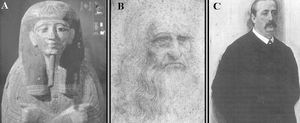To the Editor:
Santiago Ramón y Cajal complained bitterly that his publications would not have been delayed so often if his discoveries had been made in countries of greater scientific prestige, such as France or Germany, instead of Spain. Cajal knew what he was talking about. The 100th anniversary of his Nobel Prize was celebrated in 2006, and perhaps it is now fitting to remember that he was the first to show that Virchow's cell theory applied to cardiac cells, as they are individual entities delimited by a sarcolemma.1 In this letter, we would also like to help raise awareness concerning certain unknown or forgotten aspects regarding the history of ischemic heart disease.
Horemkenesi (Figure A) was a member of the priestly caste of Ammon, as well as a foreman in charge of the construction of the Pharoahs' pyramids of the Twentieth Dynasty at Thebes (around 1050 B.C.). According to the hieroglyphics found at his tomb, he had fallen suddenly onto the sand and his body was immediately infested with beetles before mummification. The forensic examination of the mummy 30 centuries later by researchers at the University of Minneapolis determined that he was approximately 60 years of age. Troponin concentrations in tissues taken from the abdominal cavity were found to be similar to the levels of individuals who had died from acute myocardial infarction (AMI) and been embalmed using a similar mummification process, and up to 15 times higher than controls who had not died from AMI.2,3 Thus, Horemkenesi is the first person in whom sudden death due to myocardial infarction has been documented.
Figure 1. A. Horemkenesi (sarcophagus), B. Leonardo da Vinci (self-portrait), C. Alexander Borodin
In 1510, Leonardo da Vinci (1542-1520) (Figure B) performed an autopsy on an elderly man who had died with no apparent cause at the Hospital de Santa Maria Nuova, in Florence. In his writings, da Vinci describes that the arteries showed considerable tortuosity and states that death was "attributable to the weakness caused by a lack of blood in the artery that nourishes the heart and lower limbs."4,5 This appears to be the first historical description of coronary death.
Alexander Borodin (1833-1887) (Figure C), composer of the unforgettable opera Prince Igor, was a renowned musician, outstanding chemist, and friend among others of Dimitri Mendelev, who discovered the periodic table of elements. He was also a famous physician who eventually became the director of the Russian Medical-Surgical Academy. After several angina attacks at age 53, Borodin died of sudden death due to ventricular rupture caused by AMI while attending a traditional Russian festival. While he was studying fatty degeneration of the myocardium, in 1871 he discovered with his colleague Krylov that this accumulation was the result of cholesterol, rather than triglycerides as expected.6 Although Borodin does not appear to have been aware of the pathological significance of his discovery, his findings came more than 40 years earlier than observations made by his fellow countryman Anichkov, who induced arteriosclerosis production in the arteries of rabbits fed a high-cholesterol diet.
These figures were clearly historical pioneers in terms of several manifestations of ischemic heart disease: Horemkenesi, of sudden death; Leonardo da Vinci, of coronary obstruction; and Alexander Borodin, of cholesterol deposits in the heart.
This work was accepted and exposed as a Comunication poster in the XXIII Reunión de la Sociedad Gallega de Medicina (Lugo, june 2-9, 2006).


